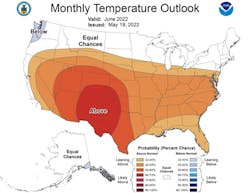2022's Summer of Weather Discontent intensifies the pace of C&I, Mission Critical Energy moves
The need for essential energy resiliency has never been greater, even in the advanced-tech 21st century.
The North America Electric Reliability Corp. recently released its summer reliability assessment. The news was troubling.
“Several parts of North America are at elevated or high risk of energy shortfalls this summer due to predicted above-normal temperatures and drought conditions over the western half of the United States and Canada,” the NERC warning reads. “These above-average seasonal temperatures contribute to high peak demands as well as potential increases in forced outages for generation and some bulk power system equipment.”
No one is safe, regardless of geography and season. Winter Storm Uri devastated Texas more than a year ago, with the freeze taking 52 GW of capacity offline, forcing load shedding and, ultimately, leading to dozens of deaths.
The twin pressures of reaching sustainability goals and ensuring energy reliability is what’s pushing the C&I Energy Transition. It is why manufacturing, commercial centers and mission critical energy users are pursuing microgrids, renewables and energy storage.
Climate change continues its damaging pace. The U.S. National Oceanic and Atmospheric Administration (NOAA) Climate Prediction Center says nearly all of the U.S. will experience higher temperatures this summer.
The drought in the western U.S. could intensify. Hydropower capacity could fall even further.
All of which makes the Energy Transition more immediate for those trying to secure cleaner, securer on-site power. These include microgrids with solar, storage and gas or diesel-fueled generator sets. Biofuels, geothermal and conventional power cogeneration.
EnergyTech will continue to cover the energy moves of larger corporations, smaller retailers, hospitals, military bases, production plants and mass transit systems, among much more. The C&I and Mission Critical Energy Transitions are headed the same direction: Greater sustainability and resiliency are intertwined.
-- -- --
(Rod Walton, senior editor for EnergyTech, is a 14-year veteran of covering the energy industry both as a newspaper and trade journalist. He can be reached at [email protected]).
About the Author
Rod Walton, EnergyTech Managing Editor
Managing Editor
For EnergyTech editorial inquiries, please contact Managing Editor Rod Walton at [email protected].
Rod Walton has spent 17 years covering the energy industry as a newspaper and trade journalist. He formerly was energy writer and business editor at the Tulsa World. Later, he spent six years covering the electricity power sector for Pennwell and Clarion Events. He joined Endeavor and EnergyTech in November 2021.
Walton earned his Bachelors degree in journalism from the University of Oklahoma. His career stops include the Moore American, Bartlesville Examiner-Enterprise, Wagoner Tribune and Tulsa World.
EnergyTech is focused on the mission critical and large-scale energy users and their sustainability and resiliency goals. These include the commercial and industrial sectors, as well as the military, universities, data centers and microgrids. The C&I sectors together account for close to 30 percent of greenhouse gas emissions in the U.S.
He was named Managing Editor for Microgrid Knowledge and EnergyTech starting July 1, 2023
Many large-scale energy users such as Fortune 500 companies, and mission-critical users such as military bases, universities, healthcare facilities, public safety and data centers, shifting their energy priorities to reach net-zero carbon goals within the coming decades. These include plans for renewable energy power purchase agreements, but also on-site resiliency projects such as microgrids, combined heat and power, rooftop solar, energy storage, digitalization and building efficiency upgrades.

